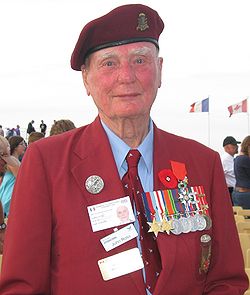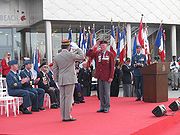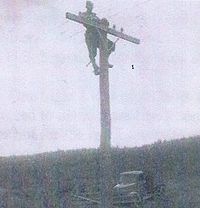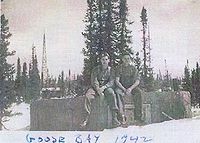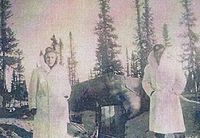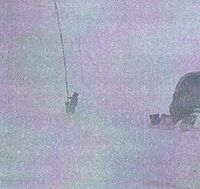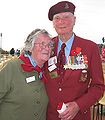Ross, John Walter
Early Life
John Walter Ross was born in Swift Current, Saskatchewan, on 12 January 1921 to parents James and Elsie.
Service
- This is only a brief summary. To read about John's service in his own words see: Story of a Signaller
John joined The New Brunswick Rangers in March 1940 as a member of the Signal Platoon. He served in various places in Eastern Canada until he volunteered for service with the 1st Canadian Parachute Battalion. He participated in Operation Overlord jumping with the Battalion into France in the early hours of 6 June 1944, D-Day. He also was involved in the Battle of the Bulge, the Germans last big offensive, which took place in Belgium in December 1944 and January 1945. At war's end, John was undergoing Officer training.
After the war, John re-enlisted with Canadian Army and served with the Royal Canadian Corps of Signals. He served six years with the Northwest Territories and Yukon Radio System before going on to serve at Camp X and, in 1958, with an Airborne Signal Troop. He served at the Royal Canadian School of Signals before being commissioned in 1965 and serving with the Special Radio Service in such places as Ladner, Alert, Ottawa and Victoria. John was awarded the Chevalier de la Legion d’Honneur (France) (French Legion of Honour) at a ceremony in France on 6 June 2014 to mark the 75th Anniversary of D-Day.Personal Life
John married Shirley Adelaide MacMillan (1923 - 1998) in 1943. Together they had three daughters and two sons.
John married his second wife, Joan in 1978.
Story of a Signaller
By John Walter Ross[1]
I suppose I should start this story with the day, on the 16th March 1940, when I joined the army during WW II. I enlisted with The New Brunswick Rangers based in Saint John, NB. For no reason, I was placed in the signal platoon.
Most items of equipment in the Rangers were hand-me-downs from WW I, including the uniforms and weapons, and they were not always complete. I remember wearing my own varied coloured shirts as part of my uniform.
The signallers received WW I style of training in the use of semaphore flags, as well as Morse Code using lamps and heliographs, Fuller phones and Don 3 telephones. All WW I equipment, and none of which was used overseas in WW II. We also had some dandy, high-powered telescopes for use with the lamps and heliographs.
The Rangers' primary role was coastal watch over the beaches leading to the Saint John docks. We laid telephone lines along the beaches and manned the telephones. Somehow, those telephones usually ended up in summer cabins.
Our transportation to get out to these places was usually a signallers private car, on loan to the army. In 1940 this was almost a rag-tag army. None of us went to a training camp. We were just given an old WW I rifle and sent out to guard the beaches.
We practiced a lot with the heliographs and lamps and got to be quite good at reading the Morse Code. It was a two-man operation; one man with the telescope reading the Morse Code, and the other man jotting down the letters as they were called out. At about 10 w.p.m. the dots and dashes could not be distinguished but the flashes of light just looked different. The flashes for a letter C, for example, looked different than the flashes for say the letter Y.
Then, in 1941, we were moved to Sydney, NS, where we did the same thing all over again. When laying telephone lines in Cape Breton; however, one had to look out for bootleg coal mines. These were holes dug quite deep and hidden from view. We had one or two close calls when pulling wire through bushes.In Sydney, we were issued a tracked vehicle called a Bren Gun Carrier. It had a radio in it; probably a No. 9 set. We used to drive through the streets of Sydney looking very high-tech, with sets of earphones on our heads.
Then some of us got educated; a course in overhead linework; climbing poles using spurs; laying telephone lines out to Big Pond, (Rita McNeil's hometown). This was followed by a course in the latest telephone and switchboard equipment. Then came a course in Fixed Wireless Stations given by very good instructors. These included an electrical engineer, an older amateur radio operator, and a veteran from the North West Territories and Yukon Radio System. It was a lengthy course of several weeks. The electrical engineer taught electricity and magnetism, the ham operator zeroed in on radio circuits and antennas, and the NWT&Y Radio System fellow had us sending and receiving telegrams at 20 w.p.m. I remember that one of the exam questions required us to draw a schematic diagram of one of three different master oscillator circuits. We thought we knew it all! Meanwhile, I became engaged to my first wife Shirley. A Sydney girl.
In the summer of 1942, we were sent to Goose Bay, in Labrador. Goose Bay, at that time, was a wilderness with a dirt air strip. We were there because "Axis Sally" had announced, in one of her broadcasts, that a German submarine would land a raiding party to destroy the new U.S. Air Force staging area at Goose Bay. A German "wolf pack" of submarines did destroy most of the convoy of the ships bringing in our supplies, including our living quarters. We lived in tents right through the winter of 1942/43. We spent all our time getting comfortable. Four men to a tent, dug down about four feet and lined with scrap lumber from a sawmill. A load of tent floors came in and these were used to roof over the tents. Stoves were made from empty 45-gallon fuel drums. Stove pipes were made from tomato cans.The U.S. Airforce would fly in convoys of aircraft from Presque Isle, Maine. One Flying Fortress bomber containing a navigator and accompanied by a flight of P38 fighter planes. The planes would be precisely lined up on the runway, straight as an arrow. After refueling in the morning, they would continue to England via Iceland. If the weather was bad over the North Atlantic the planes would be routed to England via Dakar in French West Africa.
We did a lot of fishing and hunting. We did very little communicating. There were occasional radio contacts with CIY, Sydney, and CIH, Halifax, but not using our equipment. We used the U.S. facilities. The U.S. Signal Corps also had an antenna that seemed to run for miles a few feet off the ground.
One night I was taken to an anti-aircraft gun platform to read Morse Code lights that appeared to come from a position many miles distant. Occasionally, I was able to identify a letter, but for the rest I was baffled. The artillery crew did not think too highly of my ability to read Morse. In the morning it was discovered that the lights were truck headlights, bouncing up and down, as the trucks made their way out of a gravel pit.
The mosquitoes in the summer were terrible. The -38F weather in the winter was terrible. U.S. Army personnel really suffered during the winter. They wore hard leather boots which were no protection against the cold. Their clothing, too, was of little protection against the cold. We wore wool socks inside felt boots over which we wore mukluks. We also wore sheepskin coats. We were fortunate, too, that most of the men in our unit were experienced woodsmen and farmers who knew all about winter survival.
Then came the call for volunteers for a new parachute unit. What a rush! Anything to get out of Goose Bay. I think there were several hundred volunteers. Five of us were selected and flown out in a 1929 de Havilland biplane on a bitterly cold day. The bush pilot made us push his aircraft out to the runway with his engine running. Of course, we were in the slip stream - cold, cold, cold, and no heat in the plane. Before take-off, the pilot went around tightening the wires that held the wings together with an iron bar. And would you believe a metal spring hanging from the wing was his air speed indicator?
We landed in Sept Isles on the north shore of the St. Lawrence River then caught another bush plane that got us to Rimouski on the south shore. The pilot buzzed a house, (communications?), then dropped us off several miles away in a field in the pitch dark. He told us to wait for a taxi then he took off. Taxi? There were no roads. After a couple of anxious hours, we saw headlights bobbing along toward us. It was an ordinary old car fitted with caterpillar tracks crunching over the snow. The original Bombardier perhaps?
Eventually, we made it to England as members of the 1st Canadian Parachute Battalion. Me - in the signal platoon. Shirley and I were married just before I went overseas.
In England we were issued British radio equipment, telephones, switchboards, etc. Then came training. It was vigorous. Infantry companies used No. 18 wireless sets, and the platoons had No. 38 sets. The 18 sets weighed 34 lbs. The spare parts weighed 11 lbs. The No. 38 sets were smaller. The line crews carried reels of telephone cable. Other signallers carried switchboards or telephones. All this in addition to weapons, ammunition and food. Everyone was required to carry a hand grenade, or two, a small mine called a No. 72, lots of 9 mm ammunition, a rifle or small machine gun, a plastic explosive called a Gammon bomb, and more. That was quite a load. Remember, we had no vehicles. I also attended a course at the Royal Signals School at Catterick.
On D-Day we dropped into Normandy shortly after midnight. About five hours before the seaborne troops hit the beaches. All was chaos; lots of equipment was lost. Many men were dropped miles off target. However, all objectives were taken on time by the scattered bands of men. The No. 18 sets proved to be very reliable. Never once were we out of communication during our three-month Normandy tour.
The linemen had to be very wary when repairing lines. The Germans had a habit of cutting out a length of wire which they would take with them, but they would also lay in wait for the linemen coming to repair the line. Hazards of the trade, I guess.
Following the Normandy campaign, we were returned to England to regroup and take on reinforcements. When the Germans suddenly struck back through Belgium, (the Battle of the Bulge), we were thrown in right into the German Point of Attack. We were the only Canadian unit to take part in this battle. We finally fetched up in Holland on the Maas River. Germans paratroopers on the east bank, we on the west bank. It was a sort of "Mexican stand-off'. In this position we relied mostly on telephone communications. Eventually, we were relieved by the U.S. 9th Infantry Division and we returned to England.
I was a Corporal at the beginning of the "Battle of the Bulge". Because of casualties, I ended up as the platoon commander. Anyway, the result was that I left the Battalion to attend an officer training course, while the Battalion jumped across the Rhine River into Germany and went on to meet the Russians at Wismar on the Baltic Sea.
The war with Germany ended before my course was finished and I was returned to civilian life. I went to work for the Toronto Hydro Electric System. One day I saw an ad in the paper that said the army was looking for radio operators to serve on the North West Territories & Yukon Radio System. I spent the next six years working there as an operator.
I remember reporting into the NWT&Y RS HQ in Edmonton thinking that my 20-w.p.m. code speed would impress them. Well, try to visualize a train rushing past while you try to look out the windows. It took me several months of practice before I could copy even their slow speeds. We used semi-automatic "bugs". Code speeds averaged 35 to 40 w.p.m. Whew!
After taking a seven-week weather observers' course I was sent to Fort McMurray. In 1947, the population was 1200. There were over 20 of our stations scattered across the NWT&Y, plus several Hudson's Bay posts and mining company posts in remote areas plus aircraft and river boats. Very Low Frequencies were used, 97 kHz, 117 kHz, etc. We used 10 KW transmitters and had a 50-watt VHF transmitter to talk to the airport. This VHF set often triggered responses from Houston, Texas, cabdrivers, and the U.S. Army at their Georgia Proving Grounds.
At these northern stations, everyone was expected to perform all tasks. I remember climbing a high tower to change a light bulb. I got up o.k. but when it was time to come down my feet ached so badly that I could hardly move. I was wearing boots, but the angle iron was harder.
We handled weathers and telegrams, (CP and CN), and Government telegrams as well as aircraft flight plans. A lot of traffic from private companies was in five letter cipher groups and the Lord help us if someone typed a wrong letter.
Weather was typed on what we called "weather mills", with keys having weather symbols. I saw one in storage in Lethbridge, VE6LSC. For handling weathers the Dept of Transport paid us a wage. This was in addition to army pay. We also received a northern allowance and we were able to stock a year's supply of food at very modest prices. If one stayed in the north long enough, one came out rich.
I was eventually transferred to Edmonton where I learned that incoming weather reports were typed onto teletype machines. When the teletype tape came out in the Edmonton weather office the operator there would feed it into another sender for onward transmission to Toronto, U.S.A., England and the USSR. In this way, a weather sent from, say, Resolute Bay could be in Moscow in a few minutes; or so we were told.
In 1953 I was transferred to Germany to serve as a Signals sergeant attached to the artillery. All voice procedures. Gun position officers would shout into Tannoy speakers to communicate to their command posts, but we used radio and telephones to the gun batteries. I had not known before that you could shout into a speaker and be heard on another speaker.
We lived in a German village where no one spoke English. My wife and three daughters learned to speak German and I could chat with Germans in the pub well, but it is all forgotten now.
In 1956, I was transferred to Winnipeg where my son Bill was born then we were transferred again to Camp X in Oshawa, ON. Camp X specialized in projects. Usually experimental radios and antennas. For example, I once had a VHF No. 42 set boosted to 400 watts to jam aircraft frequencies. Oshawa also had very high-powered transmitters for transmitting propaganda, etc., to Eastern Bloc countries in Europe. Antennas were the of the very large "curtain" type. Interference reports would come from Japan. One of our people once tried to load up the transmitter to maximum power and set fire to the ceiling.
About 1957, the Canadian Government hosted an International Postal Conference held in the Houses of Parliament during the summer break. We spent months building and installing on the M.P.s' desks the switching and recording equipment so that interpreters could translate to delegates in any one of five different languages. We were not allowed to wear uniforms. We were required to dress in jackets and ties as if we were civilian technicians so as not to offend delegates from some countries.
I forgot to mention in my story about the section at Camp X that specialized in sweeping government conference rooms for "bugs" that would be planted to intercept secrets being discussed. Also, trials on night vision equipment which we would do along Ottawa River beaches at night. Some behaviour by people who did not know that they were being observed could only be described as "startling". Then there was the equipment that was very sensitive to noise. In the dark an operator could tell whether he was listening to a man walking or a woman walking just by the different sounds their legs made against their clothing - and at a considerable distance, too.
We also did studies on equipment which would detect the origin and trajectory of incoming enemy mortar fire and which would then aim and automatically fire our own mortars in return. (This was in the 1950s remember). And so on.
In 1958, my son Bruce was born in Oshawa and I was asked to return to a parachute unit as a staff sergeant. I could always use a promotion, (five kids), so I said yes. This was to an airborne signal unit trained to operate in the arctic. I had not jumped for 14 years, so I took a jump masters' course and requalified as a paratrooper.
The signals role for this unit was to provide communications for an infantry unit, if it ever had to jump into the Arctic to repel an invader. We had an HF transmitter, an LF transmitter, a VHF transceiver, two 120v generators with cans of gasoline, telephone equipment for local communications along with doughnut reels of telephone cable, a Hobart heater for warmth and a tent for shelter. We had 20-foot masts for the antennas.We also had a kite which we could fly on the end of 1200 feet of cord to which was attached the vertical antenna. The antenna was made from deep sea fishing line. Everything was installed on a "heavy drop" platform which was then fitted with three 60 -foot parachutes. Everything was well padded with blankets of two-inch-thick rubberized horsehair mats. The whole thing weighed two tons. Our guy wires were secured by "snow pegs" which did not always hold up in the snow.
We would build a sort of igloo around the generators so that the exhaust from one would keep the other one warm and ready to take over. The rolls of telephone cable were wound in a doughnut shape so that when the rolls were joined, the line could be laid from a helicopter, or a sled, without snagging. The line would be paid out from the center of the doughnuts.
During my three years with this unit, the officer commanding (Bob Murray) was transferred to England and the unit was formally handed over to me. Eventually, I was recommended for a commission and sent off to the School of Signals in Kingston for assessment. My first visit to the School.
At the school I was placed on the instructional team for the Chief Radio and Telegraph Operators' Courses. These six-month courses were designed to teach communications in general to senior ranks (Sgts & WO's). These people were then expected to manage what were then called "Bridge Sites". These were underground communication centers which would be occupied by politicians in case of a nuclear war. There was one in each province and one for the Federal Government near Ottawa. These "holes in the ground" were built to withstand all but a direct hit from a nuclear bomb. They were completely self-sustaining and included offices, kitchen and sleeping quarters, deep underground.
A large computer called a "STRAD" handled all incoming and outgoing messages. It resembled a huge drum, with magnetic strips running around the outside which handled all the intelligence. As it turned, it processed the traffic. I never did learn how. Electric power was provided by local town power suppliers but in case it was knocked out, a large fly wheel, that was always kept spinning, would kick in the emergency generator which would have 12 seconds to start before all intelligence was wiped out of the STRAD.
There were escape chimneys which were filled with gravel stones. If normal entrances were blocked, a hatch at the bottom of chimney could be opened to let the rocks run out thus allowing egress through the chimney. Bunk beds in the sleeping quarters usually had posters of scantily clad ladies over them.
Occasionally, there would be an exercise when governments and their staffs would occupy the "Bridge Sites" and conduct their business. Female staff would arrive first and immediately start complaining about the configuration of their positions. Telephones would have to be rerouted and teletype machines relocated, etc. It seemed that where they sat, in relation to where their bosses were located, was very important.
In 1965, I was commissioned and transferred to what was euphemistically called "The Communications Research Branch". We did research on everyone’s communications except our own. This took me to such places as Ladner, Whitehorse, Alert on Ellesmere Island, Ottawa and Victoria. After five very interesting years in this branch of service, I retired, and my life as an army signaller ended.
In 1978, my second wife, Joan and I were married. Now, I have joined the amateur radio club at the Lethbridge Senior Centre. With much help from the club members, I am gradually learning to become a ham operator. My callsign is VE6JWR.
Related Items
References
- ↑ Formating and photos added by Col James Holsworth (Ret’d), Late RCCS, March 2020
| ||||||||
